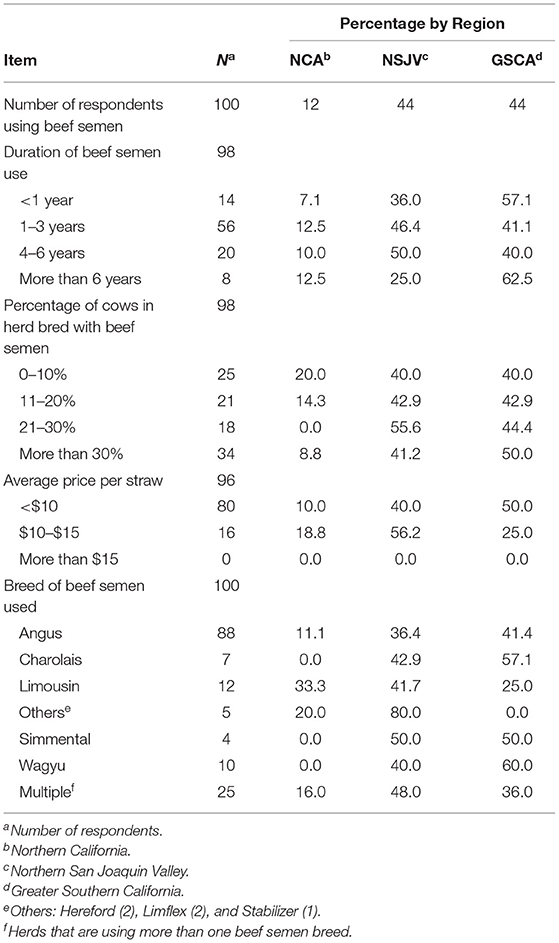- 1Department of Animal Science, Universidade Federal de Viçosa, Viçosa, Brazil
- 2Department of Population Health and Reproduction, Veterinary Medicine Teaching and Research Center, School of Veterinary Medicine, University of California, Davis, Davis, CA, United States
- 3University of California Cooperative Extension, Fresno, CA, United States
- 4Department of Animal Science, Washington State University, Pullman, WA, United States
The use of beef semen on dairy cows has been increasing steadily since 2017. We aimed to describe dairy management practices toward the use of beef semen by surveying farmers in California, the largest US dairy producer. In January 2020, we mailed a printed version of the beef semen use survey to 1,017 dairy producers in California, who also had the option to answer the survey online. The questionnaire consisted of 33 questions that were categorized into three sections: general herd information (n = 10), beef semen management (n = 17), and sexed dairy semen management (n = 6). The response rate was 13.9% (n = 141). Regression models were used to evaluate the associations between the dairy-beef crossbred sale price, use of beef semen, and use of sexed dairy semen vs. herd characteristics. The mean ± SD herd size was 1,693 ± 1,311 milking cows. Most dairies (81%) reported using beef semen on dairy cows. Among respondents, 78% reported extra profit as the main advantage of using beef semen, followed by control of heifer inventory (69%), genetic improvement (37%), and other factors (8%). Most respondents (58%) started using beef semen in the past 3 years and 34% of the respondents were breeding more than 30% of all the eligible cows with beef semen. Angus semen was the most used (reported by 89% of the respondents), followed by Limousin (12%), Wagyu (10%), Charolais (7%), others (5%, Limflex, Stabilizer, and Hereford), and Simmental (4%). Reproductive performance was an important criterion to select cows to receive beef semen and 45% of the respondents reported starting breeding cows with beef semen from the third breeding, 18% on the fourth breeding, and 21% on the fifth or greater breedings. The region of California (a proxy for type of production system) contracts with a calf ranch and the herd breed explained 76.7% of the observed variation in the day-old dairy beef crossbred calf price. Survey results demonstrated the widespread use of beef semen in dairies and the main breeding strategies adopted by dairy farmers.
Introduction
In the recent years, dairy producers have increased their interest in using beef semen on dairy cows as a strategy to increase farm profitability and manage heifer inventory (Geiger, 2019; Li and Cabrera, 2019a). The sales of beef semen in the US increased from 2.54 million doses in 2017 to 7.20 million doses in 2020, proportionally to the reduction of dairy semen sales from 23.2 million doses in 2017 to 18.3 million doses in 2020 (NAAB, 2021). This increase is associated with the use of beef semen on dairy cows (McWhorter et al., 2020). Even though this strategy is not new, dairy farmers are taking advantage of the advancements in technology in reproduction and genetics to maximize their incomes. For instance, drivers of this management include a positive trend in the reproductive performance of dairy herds (Berry et al., 2014), the increased use of sexed dairy semen since 2009 (Bickhart and Hutchison, 2016), excess supply of replacements in dairy herds, high costs to raise a purebred dairy heifer up to 24 months of age (Overton and Dhuyvetter, 2020), the increased value of dairy-beef crossbred offspring when compared to the traditional male calf, the low market price of surplus heifers (Farmers Livestock Auction, 2021), and years of depressed milk prices (USDA, 2020).
Dairy-beef crossbred calf prices have a higher market value, with reports from $125 to $254/head (Reynold Livestock Market, 2021) compared to prices from $15/head to $150/head for Holstein bull calves (Farmers Livestock Auction, 2021). The premium paid for dairy-beef crossbred calves over the market price of purebred dairy calves is an economic opportunity for dairies, as it can represent a new profit center (Basham, 2020; De Vries, 2020). If sold at 1 day of age, dairy-beef crossbred calves increase the herd income over semen cost, especially if contracts with calf ranches are made (Li and Cabrera, 2019a). Other marketing channels include marketing 400-pound feeders and retaining ownership through harvest (Basham, 2020). Additional positive outcomes of the use of beef semen on dairy herds are possible, if calving ease and beef bull fertility are considered (Morrell et al., 2018; McWhorter et al., 2020). Dairies with favorable reproductive performance (e.g., 30% pregnancy rate vs. 15% pregnancy rate for poor performance) (Li and Cabrera, 2019a) have more opportunities to combine the use of sexed dairy semen, beef semen, and other strategies such as embryo transfer. For instance, farmers can breed heifers and genetically superior cows with sexed dairy semen, while using beef semen in genetically inferior cows (Ettema et al., 2017). Furthermore, controlling heifer inventory is an important economic opportunity for dairy farmers (Overton and Dhuyvetter, 2020) and it presents additional benefits such as the reduction of the environmental footprint of dairy production through the reduction of methane and phosphorus emissions (Hristov et al., 2013; Vellinga and de Vries, 2018).
Documenting current breeding decisions adopted by dairy farmers is important to evaluate the impacts of the use of technology in reproduction and genetics as well as to understand their perceptions and attitudes toward available breeding strategies. It is also useful to identify management opportunities that would maximize the economic return of the reproductive strategy adopted. This information is important to guide research and extension activities that help farmers to maximize their economic returns of dairy operations by adjusting management decisions such as breeding strategies, heifer inventory, culling, and reproductive performance (Li and Cabrera, 2019b). Additionally, specific needs of the beef industry such as feed intake and conversion, weight gain, carcass yield, and quality are important aspects and must be considered by the dairy farmer to support a better premium price for the dairy-beef crossbred animals to guarantee the sustainability of this market (Berry, 2021; Felix, 2021).
Even though the use of beef semen by dairy herds is growing across the US (Felix, 2021), it is particularly relevant for California dairy producers who represent approximately 18.5% of all the cattle produced and 19% of the milk production in the US (California Department of Food Agriculture, 2020; USDA, 2021). Therefore, the objectives of this cross-sectional study were to describe the current management practices on the use of beef semen by dairy farms, using the California dairy industry as a model, and comparing these practices among regions of the state by herd size and breeds.
Additionally, we aimed to determine the associations between herd characteristics and the use of beef and sexed dairy semen and the price of day-old dairy-beef crossbred calves. Our hypothesis was that herd size, region of the state, and use of sexed dairy semen are associated with the use of beef semen.
Materials and Methods
Study Design
For the designed cross-sectional study, a questionnaire (Supplementary File 1) was created to obtain data on the use of beef semen by dairy herds. The state of California was chosen due to its importance for the US dairy industry and the variety of production systems according to the regions of the state. The questionnaire was reviewed and approved by the University of California, Davis Institutional Review Board (IRB ID: 1510095-1). The survey was evaluated by three dairy producers for feedback on content and organization of each question.
The questionnaire contained 33 questions and was categorized into three sections: general herd information, beef semen management, and sexed dairy semen management. Question format ranged from a single choice of multiple options, multiple choices of multiple options, and fill in the blank when the choice “other” was selected (a blank space was added to be filled by the respondent).
A complete list of California dairy producers was obtained from the California Department of Food and Agriculture in January 2020 (n = 1,256). Duplicate addresses (n = 231) were excluded from the list. Online and paper versions of the survey were created using Qualtrics (Qualtrics Research Suite, Provo, Utah, USA). First, a postcard was sent by mail to all the dairy producers on our list on January 17, 2020 (n = 1,025). The postcard contained information about the research project and survey and instructions on accessing the online version of the questionnaire. Eight postcards were returned due to an incorrect address. One week later, we mailed all the 1,017 dairy farmers a double-sided, 2-page survey and an introductory letter with the goals of study, researchers involved, the confidentiality of responses, and the method to return answers using a prepaid envelope. The first 100 respondents were rewarded with a $10 gift card. In March, a follow-up reminder postcard was sent to dairies that did not respond. Responses were received until May 30, 2020.
Responses were categorized by herd breed as pure Holstein (HO), pure Jersey (JE), and others (OT), which included mixed breeds and/or crossbred cows and by herd size (<500, 501 to 1,500, and >1,500 lactating dairy cows). Responses were compared across three regions as described in Love et al. (2016): Northern California (NCA), Northern San Joaquin Valley (NSJV), and Greater Southern California (GSCA; Figure 1), to determine whether differences in the use of beef-on-dairy across the state existed, as these regions host different production systems. This comparison is also important because herd size and management differences across these regions exist (Love et al., 2016). The number of respondents per question varied because the respondents were given the option to answer or skip questions.
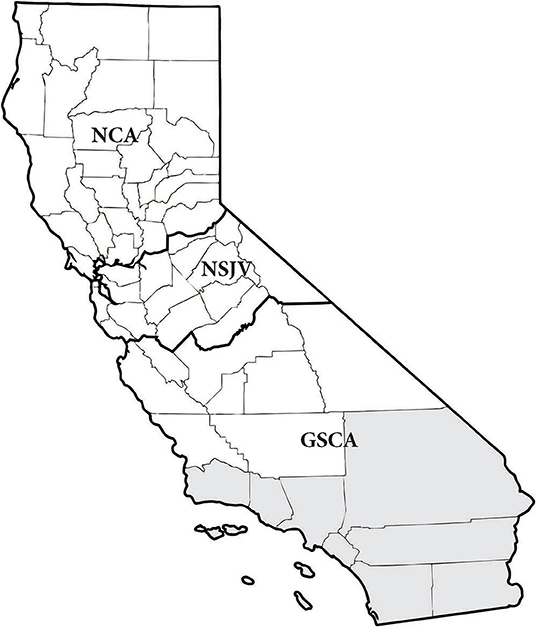
Figure 1. Map of California regions included in the beef semen survey: Northern California (NCA), Northern San Joaquin Valley (NSJV), and Greater Southern California (GSCA) (adapted from Love et al., 2016).
Questions without an answer or with an unclear response were not included in the data analyses. All the data received were recorded in a Microsoft Excel Spreadsheet (Microsoft, Redmond, Washington, USA) and later were exported into a single file into SAS 9.4 (SAS Institute Incorporation, Cary, North Carolina, USA). The error survey rate was calculated using the Survey Random Sample Calculator (Custom Insight Inc., 2010) to obtain the accuracy of our data; an error survey rate between 4 and 8% was deemed acceptable (Pollfish, 2021).
Statistical Analysis
Descriptive statistics were performed with the MEANS and FREQ procedures of SAS 9.4. The price received for the crossbred calf was a continuous variable; therefore, factors associated with it were determined using a general linear model in PROC GLM (SAS Institute Incorporation, Cary, North Carolina, USA). The factors considered were herd breed (HO, JE, and OT); region of the state (NCA, NSJV, and GSCA); herd size (≤500, 501 to 1,500, and >1,500 lactating dairy cows); average milk production (kg/cow per day); whether the farmer raised the dairy-beef crossbred calves (yes, no, or both, meaning raised some and sold some); whether a contract with a calf ranch existed (yes or no); duration of time using beef semen (<1 year, between 1 and 3 years, between 4 and 6 years, and more than 6 years); percentage of cows bred with beef semen (<10%, between 11 and 20%, between 21 and 30%, and more than 30%); and the use of sexed dairy semen (yes or no). Interactions up to the third order were tested. Significance was considered at p <0.05 and tendency at 0.05 < p < 0.10.
The use of beef semen and the use of sexed dairy semen (yes or no) were analyzed by logistic regression using PROC LOGISTIC (SAS 9.4). For the use of beef semen (response variable), predictor variables were sexed dairy semen use (yes or no); region (NCA, NSJV, and GSCA); herd size (<500, 501 to 1,500, and >1,500 lactating dairy cows); and herd breed (HO and OT; JE herds were not included as all the Jersey respondents were using beef semen). For the use of sexed dairy semen (response variable), predictor variables were beef semen use (yes or no); region (NCA, NSJV, and GSCA); herd size (<500, 501 to 1,500, and >1,500 lactating dairy cows); and herd breed (HO and OT). Two-way interactions were tested, but not kept in the model, as they were not significant.
Results
General Description of Respondents
A total of 141 responses (13.9%) from 21 countries in California were returned. Four respondents sold their operations; thus, the total number of surveys analyzed was 137, representing 10.3% of all the California dairies in 2019 (California Department of Food Agriculture, 2020). The number of respondents per region of California was proportional to the distribution of surveys mailed. Of the total surveys mailed, 17.9% were sent to dairies in NCA and 15.9% of the respondents were from this region. Likewise, 40.1 and 42.0% of the surveys were mailed to NSJV and GSCA regions and 43.6 and 40.5% of the respondents were from these regions, respectively. The sum of lactating cows from the respondents was 206,496, representing 11.9% of the total number of lactating cows in California in 2019 (California Department of Food Agriculture, 2020). Of all the respondents, 23 (16.8%) respondents responded to the survey online. Overall, the error survey rate was 7.7%, with a 95% confidence level (Custom Insight Inc., 2010). The survey response was 65.0% by owners (n = 89), 13.1% by managers (n = 18), and 1.5% by partners (n = 2). A total of 28 (20.4%) respondents did not indicate their job title.
Herd characteristics according to the region of the state are given in Table 1. Herd size ranged from 105 to 5,500 cows and the mean ± SD was 1,693 ± 1,311 lactating cows. Of the respondents, 18.8% had <500 cows (n = 23), 32.8% had between 501 and 1,500 cows (n = 44), and 48.4% had >1,500 lactating cows (n = 55). Milk production (kg/cow per day) averaged 35.2 kg and ranged from 18.1 to 45.3 kg. For all the data regardless of region, pure HO was the herd breed with the greatest number of responses (72.4%, n = 89), followed by other breeds (18.7%, n = 23) and JE breed (8.9%, n = 11). Most respondents were in the NSJV, followed by GSCA, and the fewest respondents were in the NCA. The NCA had the smallest average herd size and lowest milk production per cow.
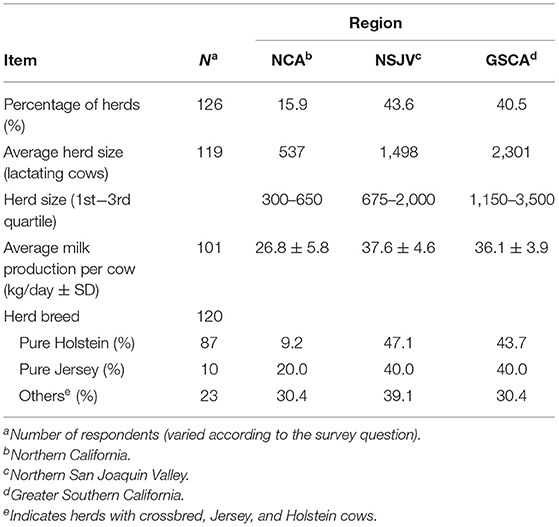
Table 1. Dairy herd characteristics of all the respondents by region of the California beef semen survey.
Beef and Sexed Dairy Semen Practices
A total of 81% of respondents were using beef semen on dairy cows (n = 103). Among those herds, two respondents were using beef embryos (1.6%) and one respondent was breeding with male-sexed beef semen (0.8%). Extra profit (78.1%, n = 75), controlling heifer inventory (69.8%, n = 67), genetic improvement (37.5%, n = 36), and other factors such as improved conception rate and reproduction (8.3%, n = 8) were the factors reported as the main advantages of using beef semen; furthermore, 54.6% of the respondents (n = 53) reported both extra profit and control of heifer inventory as the main advantages of using beef semen on their dairy cows. Among producers who were not using beef semen (n = 25), 21 were HO herds (84%) and four were herds classified as other breeds (16%). All the Jersey herds were using beef semen to breed their dairy cows. From those herds that were not using beef semen, 41.7% of HO herds were from NSJV (n = 10), 20.8% were from NCA (n = 5) and from GSCA (n = 5), and 8.3% of the other herds were from NCA (n = 2) and GSCA (n = 2).
Overall, 14% of respondents have been using beef semen for <1 year (n = 14), a higher percentage of 58% were using from 1 to 3 years (n = 58), 20% were using from 4 to 6 years (n = 20), and a small percentage were using it for more than 6 years (8.0%, n = 8). Approximately, 26% (n = 26) of the respondents were using beef semen in <10% of their herd (nulliparous and multiparous cows), 21% (n = 21) were breeding between 11 and 20%, 19% (n = 19) were using beef semen in 21 to 30%, and 34% (n = 34) were using beef semen in more than 30% of all the cows. The percentage of dairies raising their own dairy-beef crossbred calves was 19.4% (n = 19) and among those, 57.9% (n = 11) were both selling 1-day-old and raising dairy-beef crossbred calves. The majority of the respondents (82.7%, n = 81) reported a cost of <$10 per straw of beef semen and 17.3% had a cost between $10 and $15.
A summary of beef semen practices of all the respondents by California region is given in Table 2. Most respondents breeding more than 30% of their cows with beef semen were from GSCA, followed by NSJV then NCA. Figure 2 shows the most common beef breeds used by dairy farmers in California in 2020 for inseminating their cows. More than 90% of pure HO herds were breeding with Angus semen, followed by Wagyu and Charolais at <10%.
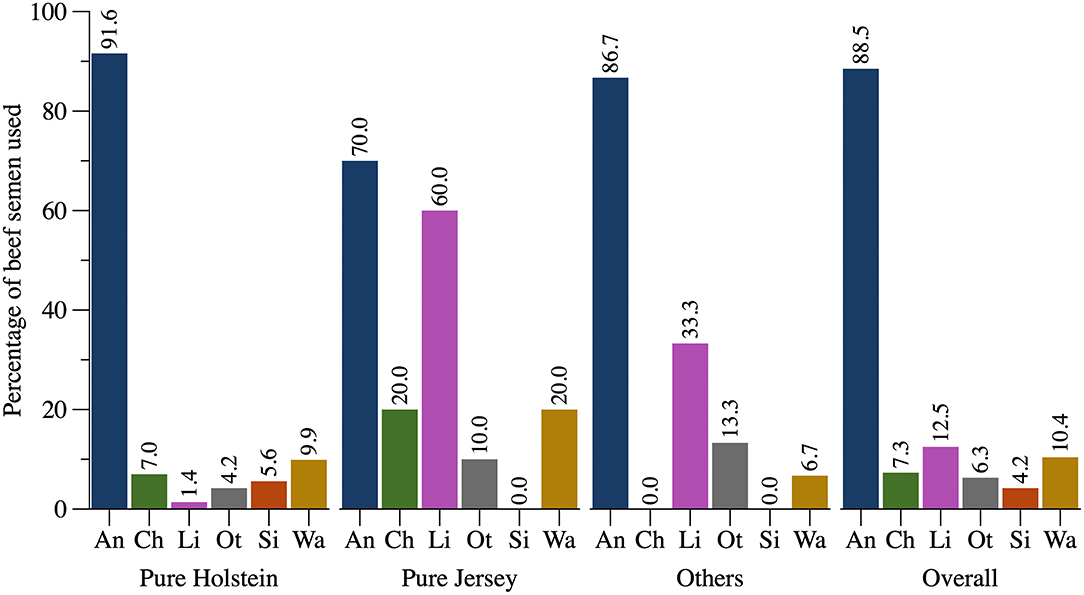
Figure 2. Most common beef semen breeds used according to dairy herd breed in California in 2020. An, Angus; Ch, Charolais; Li, Limousin; Ot, Limflex, Stabilizer, and Hereford semen; Si, Simmental; Wa, Wagyu; others, Indicates herds with crossbred, Jersey, and Holstein cows.
Pure Jersey herds mostly used Angus and Limousin semen. Other California dairy herds also were breeding mostly with Angus and a smaller percentage of Limousin semen. Overall, Angus semen was the most common single breed of beef semen used, followed by Limousin, Wagyu, Charolais, others (Limflex, Stabilizer, and Hereford), and Simmental. The proportion of respondents using more than one beef breed for inseminating their cows was the greatest for Jersey herds (80%, n = 8). Pure HO (81.7%, n = 58) and other herds (66.7%, n = 10) predominantly used one beef breed. 86% of the respondents using beef semen were also reported the use of sexed dairy semen (n = 84).
The logistic regression model results for the associations between herd characteristics and beef and sexed dairy semen use is given in Table 3. Region of the state tended (p = 0.061) to be associated with the use of beef semen where compared with the NSJV, herds in the NCA had lesser odds of using beef semen [odds ratio (OR): 0.139, CI: 0.025–0.776]. No difference was observed between GSCA and NSJV (OR: 1.077, CI: 0.289–4.016). A tendency (p = 0.067) was also observed for the association between herd size and the use of beef semen, where herds with a number of lactating cows between 501 and 1,500 had lower odds of using beef semen when compared to herds with <500 lactating cows (OR: 0.166, CI: 0.027–1.002). Herd breed was not associated with the use of beef (p = 0.446) or sexed dairy semen (p = 0.857). Farmers who use beef semen had greater odds of using sexed dairy semen (OR: 6.912, CI: 2.054–23.262) and herds with 501–1,500 lactating cows and more than 1,500 lactating cows had 5.233 and 8.597 greater odds of using sexed dairy semen than dairies with <500 lactating cows (OR: 5.233, CI: 1.181–23.177 and OR: 8.597, CI: 1.734–42.612), respectively.
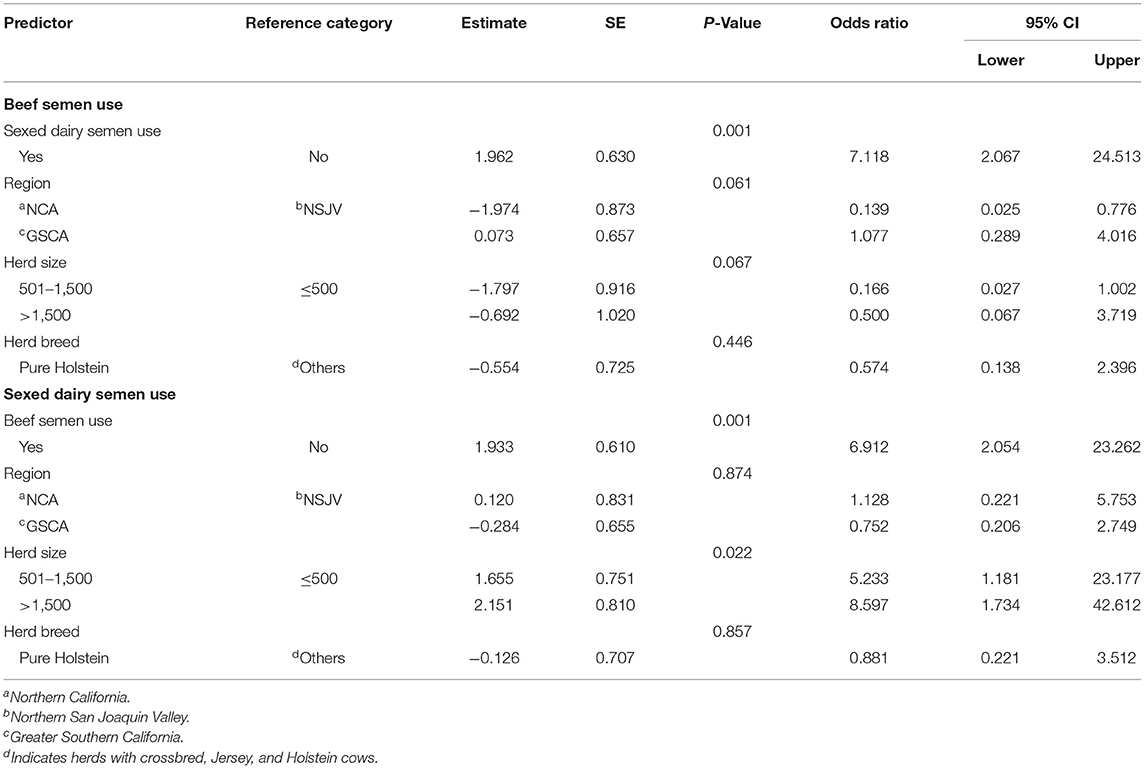
Table 3. Estimates and effect measure from a logistic regression model for the association between herd characteristics and the use of beef and sexed dairy semen by California dairies in 2020.
Cow Selection Criteria
Criteria for selecting cows for breeding with sexed semen and beef semen are shown in Figures 3A,B, respectively. Overall, lactation number (n = 46), reproductive performance (n = 37), genomic testing (n = 34), and milk production (n = 31) were the main factors producers used to select cows to breed with sexed dairy semen (Figure 3A). Sexed dairy semen was mostly being used in heifers (94.1%, n = 79) and first lactation cows (69.1%, n = 58). Based on reproductive performance, 26.4% (n = 19) of producers were breeding sexed dairy semen on their cows on first breeding, 62.5% (n = 45) on first and second breedings, 6.9% (n = 5) on first, second, and third breedings, 2.8% (n = 2) from the first to fourth breedings, and 1.39% (n = 1) were using sexed dairy semen from first to fifth breedings or more.
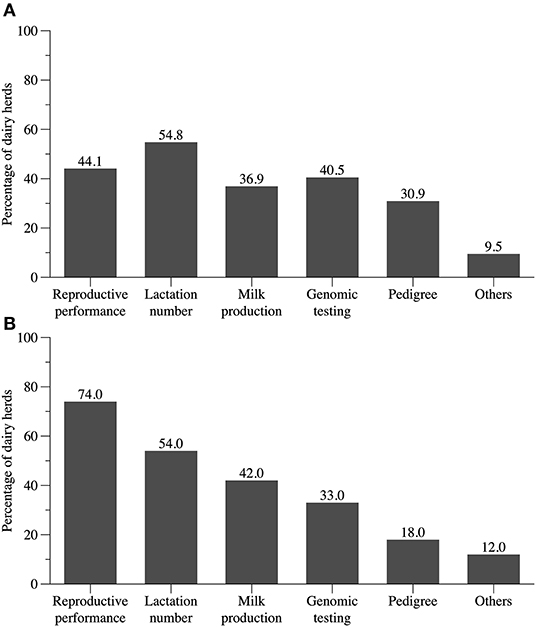
Figure 3. Distribution of dairy herds according to the main factors considered for breeding cows with (A) sexed dairy semen or (B) beef semen in 2020. Respondents had the option to select more than one strategy; thus, percentages do not total to 100%.
A total of 60% of the producers (n = 60) combined more than one criterion for selecting cows to be eligible to receive beef semen. Reproductive performance (n = 74), lactation number (n = 54), and milk production (n = 42) were the most common criteria that farmers reported for selecting cows to breed with beef semen (Figure 3B). Most farmers started using beef semen for breeding cows in their third and greater lactations (51.4%, n = 36), followed by second (37.1%, n = 26) and first (22.9%, n = 16) lactations and 25.7% (n = 18) of respondents reported starting using beef semen on their heifers.
The greatest percentage of farmers (45.0%) reported starting breeding with beef semen on the third breeding, 18.0% on the fourth breeding, and 21.0% on the fifth breeding of cow onward. Overall, preference of the calf ranch (42.3%, n = 41), cost of the beef semen (42.3%, n = 41), and calving ease (21.6%, n = 21) were the main factors driving the selection of the beef semen used, but 24.7% of respondents (n = 24) were combining more than one factor for beef semen selection. Among respondents, 9.4% (n = 9) reported issues using beef semen. Fertility (55.6%, n = 5), calf size (22.2%, n = 2), and calving difficulty (22.2%, n = 2) were the main issues described.
Dairy-Beef Crossbred Calf Price
The prices received by the respondents for their day-old dairy-beef crossbred calves are shown in Figure 4. Regardless of the herd breed, Angus-dairy crossbred calves had the greatest day-old price variation, from <$50/calf to more than $250/calf. Within HO herds, the range of day-old crossbred calf prices was between <$50/calf to more than $250/calf, but the highest prices were obtained when Wagyu and Charolais semen were used (more than $250). For Jersey herds, the day-old crossbred calf prices were between <$50/calf to $201–$250/calf. Within Jersey herds, using Charolais semen earned the best market value for the crossbred calf ($201–$250).
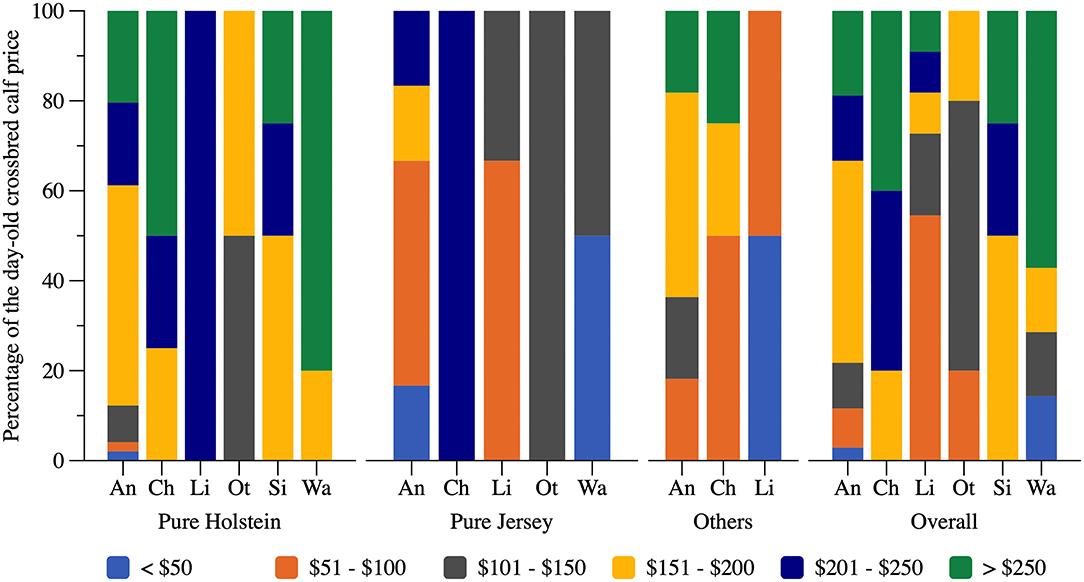
Figure 4. Distribution of the day-old dairy-beef crossbred calf sale price according to breeds of dairy cows and beef semen used in California in 2020. An, Angus; Ch, Charolais; Li, Limousin; Ot, Limflex, Stabilizer, and Hereford semen; Si, Simmental; Wa, Wagyu; others, indicates herds with crossbred, Jersey, and Holstein cows.
Region of the state (p = 0.017; 11.8%), contract with a calf ranch (p < 0.0001, 31.1%), and the herd breed (p < 0.0001, 33.8%) were associated with the price received for the dairy-beef crossbred calf, explaining 76.7% of the observed variation of the day-old crossbred calf price. The least-square mean prices (SE) for GSCA, NCA, and NSJV were $180.30 ($8.60), $136.20 ($14.50), and $157.50 ($7.90), respectively. For herd breed, the least-square means (SE) were $184.40 ($7.20, pure HO herds), $113.00 ($13.30, JE herds), and $176.60 ($10.70, OT herds). The percentage of dairies that reported contracting with a calf ranch was 41.2% (n = 40). When producers were asked the question “How do you feel the crossbred market will be in the next few years?,” 57.3% of respondents reported that the dairy-beef crossbred calf price would decrease (n = 55), few believed that the price would increase (5.2%, n = 5), and 27.1% reported that the market would remain the same (n = 26).
Discussion
This cross-sectional study summarizes the practices with respect to the use of beef semen on dairy herds adopted by dairy producers and demonstrates factors associated with the day-old dairy-beef crossbred price. The use of beef semen on dairy herds brings flexibility and economic opportunities to dairy farmers through their reproductive management program. This strategy is not new, but has gained momentum due to current market conditions. In California, most producers have started using beef on dairy in the last 4 years, regardless of herd size or breed, in accordance with the increase in the sales of beef semen in the US (NAAB, 2021). Like California, dairies in other states across the US are using beef semen as well. As reported by Agsource Dairy (2019) using data from 3,200 dairy farms from the eastern US, 16% of all the cow breedings in 2019 were with beef semen. A survey conducted in Wisconsin, Michigan, and Iowa reported that almost 80% of respondents used beef genetics on their dairy cows (Halfman and Sterry, 2019), similar to what we reported in this study. Even though our survey was conducted only among California dairy farmers, California holds almost 20% of all the dairy cattle in the US (USDA, 2021). The California dairy industry contributes 19–22% to the US beef production (Boetel, 2016), hence the importance of documenting the beef on dairy management practices in the state.
The data presented here are representative of the variety of farms that comprise the California dairy industry. Dairies in the NCA region are characterized by small herds, certified organic producers, and pasture-based herds (Love et al., 2016; California Department of Food Agriculture, 2018; Martins et al., 2019), whereas the NSJV concentrates most of the commercial, freestall, and dry lot herds.
Herds in the NCA region had lower odds of using beef and sexed dairy semen when compared to herds in the NSJV, regardless of size. Furthermore, the reported day-old dairy-beef crossbred prices received by producers in the NCA were lower than prices received by producers in the NSJV and GSCA. Differences in reproductive performance, milk price, heifer raising, and market conditions for the herds in these regions may explain these differences. Herds using beef semen had greater odds of using sexed dairy semen. This result agrees with the literature as the availability and use of sexed dairy semen allows farmers to obtain the number of heifers needed from a reduced number of breedings (De Vries, 2019), giving the producers a greater opportunity to manage their reproductive programs.
In this study, producers reported extra profit as the main perceived advantage for using beef semen on dairy cows. Overall, economic opportunities of using beef on dairy have been highlighted by other studies (Ettema et al., 2017; Li and Cabrera, 2019a). The second most important perceived advantage of using beef on dairy was the control of heifer inventory. Sexed dairy semen use, improvements in reproductive performance, and better heifer management have resulted in an excess number of replacement heifers (Bickhart and Hutchison, 2016; De Vries, 2020). The current cost of raising heifers is estimated to be $2,016 (Overton and Dhuyvetter, 2020), but the average market price for California, for instance, for females due to calve is $1,350 (Farmers Livestock Market—Oakdale, California, USA, April 2021). Therefore, raising excess replacement heifers under current market conditions may lead to economic losses (De Vries, 2020; Overton and Dhuyvetter, 2020) and increasing culling rates to accommodate excess heifers are not an optimal economic decision (De Vries, 2017). Genetic improvement of the herd was also perceived as an additional advantage of using beef on dairy and in this study, producers reported the use of genomic selection to select cows to receive sexed dairy and beef semen. This strategy increases the genetic gain, reducing the genetic lag of the herd due to the use of dairy semen on the genetically superior heifers and cows (Ettema et al., 2017; De Vries, 2019). However, the use of genomic information may be a less valuable strategy when beef semen is used and the prices of the day-old dairy-beef crossbred calves are high (De Vries, 2019).
The economic advantage of using beef on dairy would depend on herd reproductive performance, the lifespan of cows, costs of the sexed dairy and beef semen (Pahmeyer and Britz, 2020), and market conditions such as heifer and the day-old crossbred calf price (Li and Cabrera, 2019b). For instance, in an economic simulation from Li and Cabrera (2019a), considering an adequate supply of replacement heifers and a premium of $225/head paid on day-old dairy-beef crossbred calves, income from calves over semen costs would be maximized when sexed dairy semen is used in the first and second breeding of heifers, in the first breeding of first and second lactation cows, and all other breedings are done with beef semen. The reproductive practices reported by producers in this study are aligned with this strategy, as they have mostly used sexed dairy semen in heifers and first breeding of cows, with parity and breeding number being the main criteria used to select which cows would receive each type of semen.
We observed a large variation in the beef semen chosen and, consequently, in the price of the day-old dairy-beef crossbred calf. The herd breed, having a contract with a calf ranch, and the region of California where the farm is located (a proxy for the type of farm) were factors associated with the price received when dairy-beef crossbred calves were sold. The greatest variation observed for Angus crosses may be explained by the widespread use of Angus semen, which is the semen with the highest domestic sales in the US (NAAB, 2021). A greater number of Angus breedings generates data that may lead to the improvement of Angus bulls focused on dairy-beef crossbred performance (McWhorter et al., 2020), reinforcing its widespread use.
For dairy herds, conception rate and calving ease are important features that must be considered when selecting the beef bull to be used, especially due to the use of beef semen on repeated breeders (Cauffman et al., 2019; Halfman and Sterry, 2019). In this study, low conception rates, calf size, and difficult calving were common issues reported by dairy farmers when using beef semen. Besides, the sustainability of the dairy-beef crossbred market also depends on the ability of dairy farmers to provide a high-quality product that would fulfill the needs of beef industry for feed efficiency in the feedlot and carcass characteristics. In this study, most dairy farmers reported choosing beef semen on the basis of the preferences of the calf rancher purchasing the day-old dairy-beef crossbred calf. However, semen cost is a criterion used by only 18% of the dairy producers. Semen cost was reported as the most important aspect for beef semen choice by dairy producers in Iowa, Michigan, and Wisconsin (Halfman and Sterry, 2019). Even though semen cost may influence the income from calves over semen cost (Li and Cabrera, 2019a), it is possible to obtain good reproductive performance on the dairy side and greater results on feed intake and carcass weight and quality on the beef side (Twomey et al., 2020).
In this study, only 19% of respondents were raising their dairy-beef crossbred calves. Knowledge about the beef market and its needs are an opportunity for dairy farmers to increase the premium received for their dairy-beef crossbred calves, especially for Jersey herds that historically have received very low prices for their male calves (Bechtel, 2018). Dairy farmers could capture additional economic opportunities, if the ownership of dairy-beef crossbred calves were kept until 180 kg or slaughtered. Basham (2020) reported that retaining ownership of dairy-beef crossbred calves up to 180 kg would be the most profitable strategy for dairy farmers, although higher risk incurs. Therefore, it is important to consider market conditions and plan the need for replacement heifers to obtain a maximum economic return from the use of beef semen on dairy cows and economic studies evaluating the most profitable management alternative for dairy farmers are warranted.
Last, this study may contain biases as dairy producers who do not use beef semen may have been less likely to respond to the survey. Furthermore, important aspects that may determine the opportunity to use beef semen by dairy herds such as reproductive performance of the herd, breeding program, intention to expand the herd, heifer raising system and performance indexes, and type of production system were not captured by our survey. Another important consideration is that some answers were received right at the beginning of coronavirus disease 2019 (COVID-19) pandemic in the US, affecting dairy and beef markets greatly, and possibly affecting some of the responses obtained.
Nonetheless, the information presented here demonstrates the multiplicity of beef on dairy strategies adopted by farmers and highlights the need for further studies on the topic.
The results of this study demonstrated the widespread use of beef semen in dairy herds. Parity and breeding number were the main criteria that dairy farmers used to choose which cows to receive sexed dairy and beef semen. There was high variability in the price received for the day-old, dairy-beef crossbred calf, and having a contract with a calf ranch, Angus crosses, and breed of the dairy herd were associated with the calf price. The beef strategies on dairy practices reported here may not differ from other dairy herds across the US, but herd reproductive performance and market conditions may influence the adopted reproductive strategy.
Data Availability Statement
The raw data supporting the conclusions of this article will be made available by the authors, without undue reservation.
Ethics Statement
The studies involving human participants were reviewed and approved by the University of California, Davis Institutional Review Board (IRB ID: 1510095-1). The participants provided their written informed consent to participate in this study.
Author Contributions
FF secured funding for the study. FF and DB contributed to conception and design of the study. JP and FF organized the distribution of the survey. JP led the data management and performed statistical analysis, overseen by FF and MM. JP wrote the first draft of the manuscript. JP, MM, and FF wrote the manuscript. All authors contributed to manuscript revision and approved the submitted version.
Funding
Scholarship by the JP was supported by the Conselho Nacional de Desenvolvimento Científico e Tecnológico (CNPq).
Conflict of Interest
The authors declare that the research was conducted in the absence of any commercial or financial relationships that could be construed as a potential conflict of interest.
Publisher's Note
All claims expressed in this article are solely those of the authors and do not necessarily represent those of their affiliated organizations, or those of the publisher, the editors and the reviewers. Any product that may be evaluated in this article, or claim that may be made by its manufacturer, is not guaranteed or endorsed by the publisher.
Acknowledgments
JP thanks CNPq, Brasilia, Federal District, Brazil, for financial support of her graduate studies. The authors also thank the California dairy farmers for their collaboration on this study and Bill VerBoort (AgriTech, California) for his valuable insights and feedback on this study.
Supplementary Material
The Supplementary Material for this article can be found online at: https://www.frontiersin.org/articles/10.3389/fanim.2021.785253/full#supplementary-material
References
Agsource Dairy (2019). Technological Advances and Economics: How Farm Management is changing because of it. Agsource Dairy. Available online at: https://dairy.agsource.com/2019/05/16/technological-advances-and-economics-how-farm-management-is-changing-because-of-it/ (accessed March 13, 2020).
Basham, W. (2020). Dairy-Beef Retention Options. (Master's thesis), Kansas State University, Manhattan, KS (USA).
Bechtel, W. (2018). Stabilizing Jersey Calf Prices for Beef Markets With Crossbreeding. Available online at: https://www.thepacker.com/markets/know-your-market/stabilizing-jersey-calf-prices-beef–crossbreedingmarkets-crossbreeding (accessed November 25, 2020).
Berry, D. P. (2021). Invited review: beef-on-dairy—The generation of crossbred beef × dairy cattle. J. Dairy Sci. 104, 3789–3819. doi: 10.3168/jds.2020-19519
Berry, D. P., Wall, E., and Pryce, J. E. (2014). Genetics and genomics of reproductive performance in dairy and beef cattle. Animal 8, 105–121. doi: 10.1017/S1751731114000743
Bickhart, D. M., and Hutchison, J. L. (2016). Sexed-semen usage for holstein AI in the United States. J. Anim. Sci. 94:180. doi: 10.2527/jam2016-0372
Boetel, B. (2016). Impacts of the Dairy Industry on Beef Markets. Available online at: https://u.osu.edu/beef/2016/07/20/impacts-of-the-dairy-industry-on-beef-markets/ (accessed February 23, 2021).
California Department of Food Agriculture (2018). California Agricultural Production Statistics. California Department of Food and Agriculture. Available online at: https://www.cdfa.ca.gov/Statistics/PDFs/2017-18AgReport.pdf (accessed February 10, 2021).
California Department of Food Agriculture (2020). California Agricultural Production Statistics. California Department of Food and Agriculture. Available online at: http://www.cdfa.ca.gov/Statistics/PDFs/2020_Ag_Stats_Review.pdf (accessed February 10, 2021).
Cauffman, A., Educator, E. A., County, G., Sterry, R., Agent, E. A., County, S. C., et al. (2019). Considerations for Breeding Dairy Cattle to Beef Breeds for Meat Production. Available online at: https://fyi.extension.wisc.edu/wbic/files/2019/07/Beef-on-Dairy-Sire-Selection-07-16-19.pdf (accessed February 25, 2021).
De Vries, A. (2017). Economic trade-offs between genetic improvement and longevity in dairy cattle. J. Dairy Sci. 100, 4184–4192. doi: 10.3168/jds.2016-11847
De Vries, A. (2019). “Culling, beef and sexed semen: which strategies make economic sense?,” in Proceeding Dairy Cattle Nutrition Workshop (Hershey, PA).
De Vries, A. (2020). Symposium review: why revisit dairy cattle productive lifespan?. J. Dairy Sci. 103, 3838–3845. doi: 10.3168/jds.2019-17361
Ettema, J. F., Thomasen, J. R., Hjortø, L., Kargo, M., Østergaard, S., and Sørensen, A. C. (2017). Economic opportunities for using sexed semen and semen of beef bulls in dairy herds. J. Dairy Sci. 100, 4161–4171. doi: 10.3168/jds.2016-11333
Farmers Livestock Auction (2021). Market Watch: Cattle. Farmers Livestock Auction. Available online at: https://www.progressivedairy.com/news/organizations/market-watch-cattle (accessed January 27, 2021).
Felix, T. (2021). “The role of nutrition & imoants in dairy beef health & animal performance,” in Proceeding I-29 Moo University–Dairy Beef Short Course (Orange City).
Geiger, C. (2019). Beef-on-Dairy Semen Sales Skyrocketed in 2018. Available online at: https://hoards.com/article-25428-beef-on-dairy-semen-sales-skyrocketed-in-2018.html (accessed March 19, 2020).
Halfman, B., and Sterry, R. (2019). Dairy Farm Use, and Criteria for Use, of Beef Genetics on Dairy Females. Available online at: https://hoards.com/article-25428-beef-on-dairy-semen-sales-skyrocketed-in-2018.html (accessed February 25, 2021).
Hristov, A. N., Ott, T., Tricarico, J., Rotz, A., Waghorn, G., Adesogan, A., et al. (2013). SPECIAL TOPICS-mitigation of methane and nitrous oxide emissions from animal operations: II. A review of manure management mitigation options. J. Anim. Sci. 91, 5070–5094. doi: 10.2527/jas.2013-6584
Li, W., and Cabrera, V. E. (2019a). “Economics of using beef semen,” in Proceeding Western Dairy Management Conference (Reno, NV), 66–79.
Li, W., and Cabrera, V. E. (2019b). “Dairy × beef: fad or sustainable future,” in Proceeding Dairy Cattle Reproduction Council Conference (Pittsburgh, PA; New Prague, MN: Dairy Cattle Reproduction Council), 32–40.
Love, W. J., Lehenbauer, T. W., Karle, B. M., Hulbert, L. E., Anderson, R. J., Van Eenennaam, A. L., et al. (2016). Survey of management practices related to bovine respiratory disease in preweaned calves on California dairies. J. Dairy Sci. 99, 1483–1494. doi: 10.3168/jds.2015-9394
Martins, J. P. N., Karle, B. M., and Heguy, J. M. (2019). Needs assessment for cooperative extension dairy programs in California. J. Dairy Sci. 102, 7597–7607. doi: 10.3168/jds.2018-15959
McWhorter, T. M., Hutchison, J. L., Norman, H. D., Cole, J. B., Fok, G. C., Lourenco, D. A. L., et al. (2020). Investigating conception rate for beef service sires bred to dairy cows and heifers. J. Dairy Sci. 103, 10374–10382. doi: 10.3168/jds.2020-18399
Morrell, J. M., Valeanu, A. S., Lundeheim, N., and Johannisson, A. (2018). Sperm quality in frozen beef and dairy bull semen. Acta Vet Scand. 60:41. doi: 10.1186/s13028-018-0396-2
NAAB (2021). Annual Reports of Semen Sales and Custom Freezing. NAAB. Available online at: https://www.naab-css.org/semen-sales (accessed April 6, 2021).
Overton, M. W., and Dhuyvetter, K. C. (2020). Symposium review: An abundance of replacement heifers: what is the economic impact of raising more than are needed? J. Dairy Sci. 103, 3828–3837. doi: 10.3168/jds.2019-17143
Pahmeyer, C., and Britz, W. (2020). Economic opportunities of using crossbreeding and sexing in Holstein dairy herds. J. Dairy Sci. 103, 8218–8230. doi: 10.3168/jds.2019-17354
Pollfish (2021). Margin of Error & Sample Size Calculator. Pollfish. Available online at: https://www.pollfish.com/margin-of-error-calculator/ (accessed November 8, 2021).
Reynold Livestock Market (2021). Reynolds Livestock, LLC. Reynold Livestock Market. Available online at: https://www.reynoldslivestock.com/what-we-offer-pricing (accessed March 31, 2021).
Twomey, A. J., Ring, S. C., McHugh, N., and Berry, D. P. (2020). Carcass and efficiency metrics of beef cattle differ by whether the calf was born in a dairy or a beef herd. J. Anim. Sci. 98, 1–11. doi: 10.1093/jas/skaa321
USDA (2020). Economics, Statistics and Market Information System. USDA. Available online at: https://usda.library.cornell.edu/concern/publications/c821gj76b?locale=en (accessed October 30, 2020).
USDA (2021). Cattle Cows Milk Inventory 2019. USDA. Available online at: https://usda-reports.penguinlabs.net/?crop=cattle_cows_milk&statistic=inventory_head&yearet&year=2019 (accessed March 30, 2021).
Keywords: beef on dairy, beef semen, sexed dairy semen, reproductive strategy, dairy-beef crossbred calves
Citation: Pereira JMV, Bruno D, Marcondes MI and Ferreira FC (2022) Use of Beef Semen on Dairy Farms: A Cross-Sectional Study on Attitudes of Farmer Toward Breeding Strategies. Front. Anim. Sci. 2:785253. doi: 10.3389/fanim.2021.785253
Received: 28 September 2021; Accepted: 08 December 2021;
Published: 18 January 2022.
Edited by:
Erin E. Connor, University of Delaware, United StatesReviewed by:
Stephen Butler, Moorepark Animal and Grassland Research Centre, Teagasc, IrelandBradley Heins, University of Minnesota Twin Cities, United States
Copyright © 2022 Pereira, Bruno, Marcondes and Ferreira. This is an open-access article distributed under the terms of the Creative Commons Attribution License (CC BY). The use, distribution or reproduction in other forums is permitted, provided the original author(s) and the copyright owner(s) are credited and that the original publication in this journal is cited, in accordance with accepted academic practice. No use, distribution or reproduction is permitted which does not comply with these terms.
*Correspondence: Fernanda Carolina Ferreira, ZmNmZXJyZWlyYUB1Y2RhdmlzLmVkdQ==
 Jessica Marcela Vieira Pereira
Jessica Marcela Vieira Pereira Daniela Bruno
Daniela Bruno Marcos Inacio Marcondes
Marcos Inacio Marcondes Fernanda Carolina Ferreira
Fernanda Carolina Ferreira